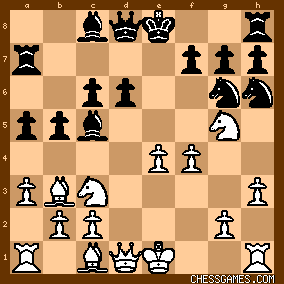| KEG: Schlechter was definitely one of the pre-tournament favorites at Monte Carlo 1901, having shared first place with Pillsbury at Munich 1900. But his start in the tournament did not live up so any lofty expectations. With five rounds completed, Schlechter had won only one game against one loss and four draws (two of which had to be replayed). Running into Winawer, who was barely ahead of last-place Didier going into this round, was just what the doctor ordered for Schlechter. This was not a pretty win, but Schlechter did what he had to in order to defeat a player who was a class below him and was having a miserable tournament.
After winning this game, Schlechter went on a tear and was only relegated to 2nd place because of his later loss to tournament winner Janowski. 1. e4 Nc6
So far as I know, this was the only time Schlechter adopted what later came to be know as the Nimzowitsch Defense. Perhaps he wanted to shake up Winawer from the start. 2. d4 e5
The text and 2...d5 are the most popular lines. The latter choice seems sounder and more in Schlechter's style. The text probably reflects Schlechter's determination to play for a win. 3. dxe5
3. d5 is the usual move here, but the text is also reasonable. 3... Nxe5

click for larger view4. f4?!
"Sharper, but only by appearance." (MCO-13).
4. Nf3 (probably best) is the usual move here. The text is an effort to try to punish Black for his choice of opening. It is certainly playable and yields a small edge for White at the cost of some King-side weakening. 4... Ng6?!
4...Nc6 was soundest and theoretically best. Schlechter, however, seems to have wanted to mix it up even at this early stage of the game. 5. Nf3 Bc5
"!"--(MCO-13).
MCO-13 notwithstanding, 5...Bb4+ looks best. But, once again, Schlechter seems to have been keen on a brawl in this game. 
click for larger view6. Bc4
Strongest for White here were the developing 6. Nc3 (preparing to castle long) or the aggressive 6. f5. 6... d6
6...c6 could also have been played.
7. Nc3 c6!
Combining offense (by opening the diagonal for the Queen) and defense (keeping White's Knight off d5 and preparing for an eventual d5). The position reached, so far as I am aware, has never otherwise occurred. 
click for larger view8. Ng5?!
This should have led to trouble for Winawer. There was nothing wrong with his position at this stage, and he could have continued developing and preparing to castle long with 8. Qe2 or pressed forward with 8. f5. Alternatively, and in anticipation of a possible d5 from Black, Winawer could have just played 8. Bb3 All of these moves seem to give White a small advantage. 8... Nh6
9. h3
This does little to advance White's cause. Despite his doubtful 8th move, White still had numerous reasonable options, e.g., 9. Na5, 9. Be2, 9. f5. The text allows Black to assume the initiative. 9... b5
9...0-0 was also good.
10. Bb3 a5
Schlechter decided upon a Queen-side assault. 10...0-0 was also favorable for Black. 11. a3 Ra7?!
A move that was not in my mental database when I played over the game. From a7, the Rook defends f7 and prepares to swing over to e7 as needed while still keeping an eye on the a-file. Nonetheless, 11...0-0 or 11...a4 or 11...Qe7 seem simplest and better. After Schlechter's 11...Ra7?!, the position was: 
click for larger view | 




































